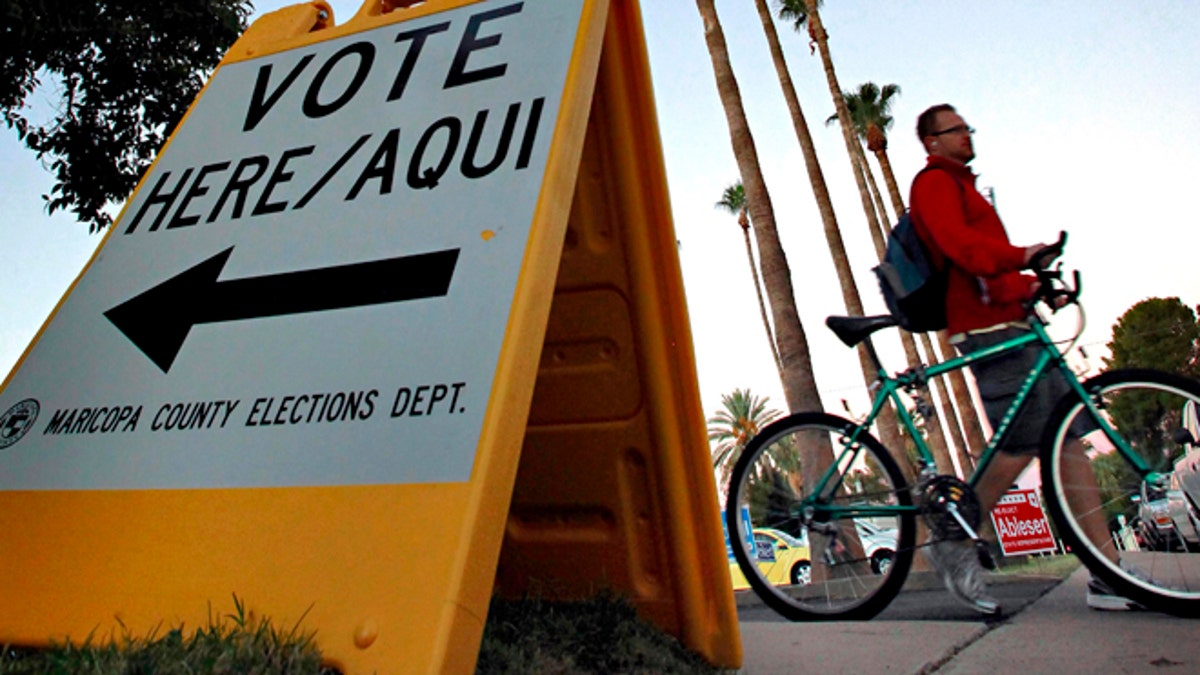
FILE - A sign directs voters to a polling station in Tempe, Ariz., in this Nov. 2, 2010, file photo. The Supreme Court ruled Monday, June 17, 2013 that states cannot on their own require would-be voters to prove they are U.S. citizens before using a federal registration system designed to make signing up easier. The justices voted 7-2 to throw out Arizona's voter-approved requirement that prospective voters document their U.S. citizenship in order to use a registration form produced under the federal "Motor Voter" voter registration law. (AP Photo/Matt York, File)
Over a week ago, in the case of Shelby County v. Holder, the U.S. Supreme Court struck down Section 4 of the Voting Rights Act of 1965 (“VRA”) which includes the formula used to determine which states and localities must obtain preclearance before making a change in law that affects voting rights. Various groups immediately denounced the decision as a disastrous return to days of intimidation and discrimination against minority voters. In dissent, Justice Ruth Bader Ginsburg referred to the majority decision as an act of “hubris” for ignoring the bipartisan congressional reauthorization of the VRA just seven years earlier.
Lost in much of the media criticism of the decision is any acknowledgment that the Court left intact Section 2 of the VRA, the substantive law protecting the voting rights of Americans.
The Supreme Court hinted strongly in the 2005 case of Northwest Austin Municipal Utility District Number One v. Holder, of serious doubts about the constitutionality of certain portions of the VRA, saying the law “imposes current burdens and must be justified by current needs.” For this reason, when the reauthorization of the VRA was being discussed in 2006, the Justice Department raised questions about provisions such as Section 4. However, it soon became apparent that many Republicans had little appetite to amend the VRA for fear of alienating a growing and influential block of minority voters.
While I condemn actions to intimidate and discriminate against minority voters, and salute the work of the career professionals in the Civil Rights Division during my tenure as Attorney General, I agree with the Court’s decision in Shelby. Section 5 of the VRA requires covered jurisdictions to obtain federal clearance from either the Civil Rights Division of the Department of Justice or a panel of federal judges on the U.S. District Court for the District of Columbia. The Section 5 preclearance requirements were meant to address disenfranchisement of African Americans in Southern states. However, its application is based on a formula in Section 4 of the VRA that the Court in Shelby found was woefully outdated, not reflective of today’s society and oblivious to progress made since 1965 in the levels of voting participation by minorities. The Court’s decision to strike down Section 4 in essence renders the Section 5 requirements inapplicable.
Lost in much of the media criticism of the decision is any acknowledgment that the Court left intact Section 2 of the VRA, the substantive law protecting the voting rights of Americans. Following this decision, the U.S. Attorney General warned jurisdictions that the Civil Rights Division will be closely monitoring their actions to ensure the protection of voting rights under Section 2. If, over time, those efforts prove inadequate, Congress can pass legislation and revise the Section 4 formula to reflect the realities of modern America.
Some states have already announced they are moving forward on certain measures affecting voting such as requiring a photo ID to vote. Whether the Court’s decision in Shelby will, over time, adversely impact minority voting rights remains to be seen. If so, the American people should demand that Congress do its job and pass legislation that imposes burdens that are justified by current needs so that no American –irrespective of race– is denied the right to vote.








































